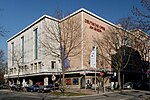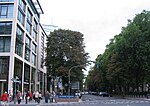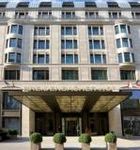Dreischeibenhaus

The Dreischeibenhaus (also known as the Dreischeibenhochhaus) is a 95-metre office building in August-Thyssen-Straße in the Hofgarten district of the Düsseldorf city centre. It was also known as the Thyssenhaus or Thyssen-Hochhaus owing to its former use as the headquarters of the Thyssen and ThyssenKrupp groups. It is among the most significant examples of post-war modernist International style and a symbol of the so-called Wirtschaftswunder, or 'economic miracle' of post-war Germany, and contrasts with the neighbouring Düsseldorfer Schauspielhaus on Gustaf-Gründgens-Platz. Dreischeibenhaus, The "Three Plates Building" (a rough translation of its name in German), was one of the first skyscrapers to be completed in Germany after WW2.In the early 1990s the building was completely refurbished including a new curtain wall matching the appearance of the original, but with improved thermal performance and moisture control.After another complete renovation under the direction of Düsseldorf HPP Architects in 2013, the skyscraper now offers 35,000 m2 of gross floor area.
Excerpt from the Wikipedia article Dreischeibenhaus (License: CC BY-SA 3.0, Authors, Images).Dreischeibenhaus
Dreischeibenhaus, Dusseldorf Stadtmitte (Stadtbezirk 1)
Geographical coordinates (GPS) Address External links Nearby Places Show on map
Geographical coordinates (GPS)
| Latitude | Longitude |
|---|---|
| N 51.227777777778 ° | E 6.7822222222222 ° |
Address
Dreischeibenhaus (Thyssen-Haus)
Dreischeibenhaus 1
40211 Dusseldorf, Stadtmitte (Stadtbezirk 1)
North Rhine-Westphalia, Germany
Open on Google Maps










